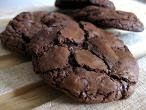During the afternoon I started to think that my stew plan was a bit boringly healthy for a Friday feeling, and began hoping that my dough didn't rise after all. My secret hope was answered when I went to check on it after three hours: it sat in its bowl looking exactly as I had when I put it there, as if to say 'well what did you expect when you didn't give me any nice nurturing warmth to get my yeast going?' I emailed The Scientist to tell him that dinner was foraging, and since he's a boy, and being set loose in the ready meals section of the supermarket is almost always preferable to a low fat stew, he was happy. The dough got wrapped in plastic and stashed in the fridge in the hope that it could be transformed into something that required a little less rising.

The next night I was making a Moroccan stew, and I thought that flatbreads would be a lovely accompaniment. The dough was duly brought out again and left at room temperature before being rolled out thinly. Since it was very plain I added some toppings for extra flavour. On one I spread some garlic relish, in honour of its French origins, and on the other, some cumin seeds, having kneaded some cumin powder into the dough before rolling to fit in with the spicy stew. I baked them at about 220C for about 10 mins or so, with no idea as to whether they would even be edible.

In fact, they were the best flatbreads I've ever made! My previous flatbreads (generally the Nigella seed breads from How to Be a Domestic Goddess) are very nice, but somewhat puffy - more like a naan than a pitta. These ones were flatter and a little crunchier, and so were better (I thought) for scooping couscous and veggies - a foil to the meal if you will, rather than a big bite in their own right. We both liked both the toppings very much. The garlic one was quite sweet as it was more of a jam than a savoury relish, and the cumin taste was assertively present without dominating the dish. After a very inauspicious start, these are now my flatbreads of choice! My one problem is that I don't know whether to try them with warm water, or whether they would lose their character. But in that case, are they really a bread?!

After their miraculous resurrection from the brink of yeast despair I am sending these flatbreads to My Diverse Kitchen, who is hosting Bread Baking Day on the theme of small breads this month.
Little French flatbreads (adapted from Small Batch Baking by Debby Naugans Makos)
The original recipe was for 2 boules; I guestimated the quantities up by half so as to make three, so these quantities are a bit rough
1 cup white bread flour, plus more as needed, and for dusting the work surface
3/4 tsp salt
a very scant 1/2 tsp rapid-rise yeast
olive oil, for greasing the bowl
Place flour, salt and yeast in a food processor and process for three seconds to blend. With the machine running, pour a bit under half a cup of [cold] water through the feed tube. Process until the dough holds together, about 20 seconds. The dough should be a sticky mass, and it should appear difficult to knead by hand. If the dough is too dry, add more water, a tablespoon at a time, processing for five seconds after each addition.
Lightly grease a medium sized mixing bowl with olive oil. Place the dough in the bowl and turn it to coat it with the oil. Cover the bowl loosely with plastic wrap and let the dough rest. [I don't know if this is at all necessary if using cold water - this was the instruction for the French bread part!]. Roll the dough out thinly and top with any seeds/relishes you fancy. You can also knead flavourings into the dough.
Bake at 220C for 10-12 minutes keeping an eye on it.



5 comments:
Your French boule turned flatbreads look very good.
I'm all for crunchy faltbreads.
Thanks for participating in BBD.
I'm glad your French flatbread worked out for the best!
Here is my two cents regarding bread baking;
I always use cold water when using "instant" or "rapid rise" yeast, which can be added directly to the dry ingredients before adding the cold water. If using "active dry yeast" you typically need to proof it with a bit of warm water before adding the flour, etc. Cold water should actually activate any type of yeast but will take a bit longer then if you use warm water.
Cold water is usually preferable because you want a very slow rise to develop the flavor.
By refrigerating the dough (retarding it) overnight you gave it 24 hours to develop flavor and character. Time is your friend when baking bread!
Have you ever made the famous "No-Knead Bread" recipe? It's on my blog along with some variations. It requires only 1/4 tsp instant yeast and cold water along with a 18 hour initial rise.
In case you haven't seen it, here is the original You Tube video.
http://www.youtube.com/watch?v=13Ah9ES2yTU
Let me know what you think after you see the video!
I think these look interesting but was wondering how much the sitting in the fridge overnight helped them - you seem to suggest in your recipe that they don't really need much time at all to rest - did your dough rise at all?
Thank you everyone! And thank you especially for the advice, Lisa - that's really interesting. I hadn't realised that cold water was fine for instant yeast. My dough didn't look any more rise in the morning but I'm sure you're right about the flavours having time to develop. I might build that into my breadmaking plans more often from now on. I've got the no-knead dough on my list of breads to try but haven't got to it yet - I'll go and take a look at how the experts do it first!
I bet this smelled great. I love cumin and garlic.
Post a Comment